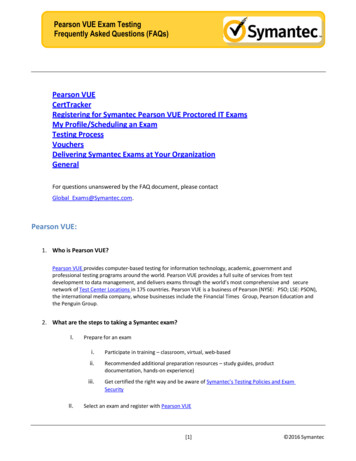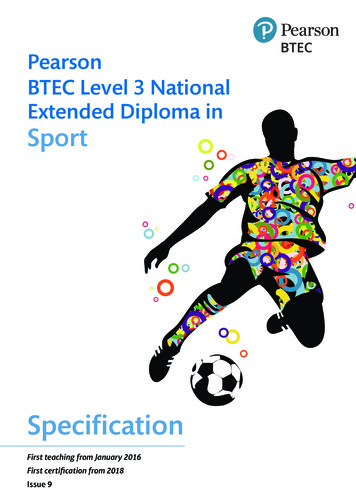
Transcription
FactorsThatInfluenceAssessmentAnne-Marie Kimbell, PhD, MSEd, and Chris HuzinecFactors that impact or influence performance in a testing situation includeclient/patient/student factors, clinician factors, environmental factors, and thoseinvolving the actual testing process itself. This brief highlights these factors forboth adult clients and children/students.Factors that influence child and school-based assessmentThe challenge:While the assessments used in school settings have varying degrees of standardization and psychometricproperties, most have more than acceptable levels of reliability and validity. So, when used appropriately withfidelity, assessments can be expected to provide useable information about students. However, in additionto whether standardized testing is a good indicator of student performance, there is also debate on whethercertain aspects in life—physical, mental, or situational—affect students’ assessment results. When working witheducators, it is important that Clinicians and School Psychologists have a firm understanding of these factors inorder to more accurately communicate the results obtained from assessment and other measures of studentperformance and behavior.
Factors That Influence AssessmentPhysical factors Age level—The chronological age of a student is typically accounted for intest or assessment form selection Developmental level—Should be considered if a student is developmentallydelayed or advanced when comparing to same-age cohorts Physical disabilities—Hearing loss, visual impairment, motor ability, etc. General health condition Had the student eaten that day? Did the student get enough sleep? Is there a history of substance abuse? What is their receptive and expressive language ability? Is the child on medication or off his/her normal medication? Is the student suffering from cold, flu, allergies, or other condition?Mental/behavioral factorsWhat is the student’s: Motivation level School learning ability level Special Ed, IEP, or 504 accommodations Activity/attention level (e.g., impulsive, distracted, etc.) Cognitive level (developmentally delayed or advanced) Specific mental health history (including comorbid or previous diagnoses,past trauma) Behavior (e.g., agitated, noncompliant, aggressive, shy, withdrawn,compulsive, anxious, frustrated, insecure, rejected, etc.)Home factors Is the child homeless? Is the child in foster care? Is the child a member of a migrant family? Are there cultural differences? Does the student have a stable home life, or have they had a recent changeat home? Do the parents support assessment? Do they have issues with assessmentsand tests? Is the student a native speaker of another language, is he/she bilingual, or isthe primary home language not English? Do the parent(s) or caregiver take an interest in their child’s education or dothey have an issue with education?2
Factors That Influence AssessmentSchool factors Does the student feel safe and/or connected at school? Does the student have a history of chronic absenteeism? Was there a fire drill or other unplanned emergency drill? Is the student markedly over- or under-age for the grade? Does the student have cultural support or disconnection? What is the student’s level of socialization and peer support? How well does the student relate to teachers and other schoolprofessionals? Was the child pulled from a class or school event he/she enjoys for thesession? What is the testing environment (e.g., classroom or office lighting, noiselevel, temperature, amount of interruptions)?Rater/teacher/clinician factors Cultural differences Language differences? Implicit basis? Rapport and management skills Previous experience with the student Amount and frequency Physical and mental state of the tester Fidelity to assessment qualifications and instructions Familiarity with the testing environment and test materials Interpretation experience/knowledge (e.g., discrepancy analysis, growthscale values, etc.)3
Factors That Influence AssessmentFactors that influence adult and older adult assessmentThe challenge:Even when a thorough process is followed for instrument section, other conditions are often present during thetesting session that may impact the performance and test results. Clinician awareness of these factors and theirpotential impact on testing results is important to ensure maximum performance and accurate results.Physical & sensory factors Fatigue Polypharmacy Substance use Medication effects Impaired vision or hearing Hunger and/or poor nutrition Altered cognition due to delirium Impaired gross or fine motor skills Chronic or acute medical conditions Severely slowed psychomotor speed Severely impaired language function4Mental/Behavioral factors Substance abuse History of trauma Significant agitation Intellectual disability Cognitive impairment Significant impulsivity Severely impaired attention Alcohol and drug interactions Poor effort / lack of cooperation / low arousal Specific mental health issues (significant anxiety,depression, or comorbid conditions)
Factors That Influence AssessmentEnviromental factors Accessibility Literacy level Bedside vs. office Caregiving concerns Cohort effects/culture Test stimulus materials Digital anxiety/familiarity Family influence/expectations Access to healthcare/medication Primary language other than English Living situation (stable, isolated, homeless) Availability of appropriate corrective devices,accommodations Environmental concerns (lighting, ventilation,temperature, free from distractions)Clinician factors Test selection Cultural differences Language differences Implicit bias Administration and/or scoring errors Norms appropriate for person being assessed Interpretation experience/knowledge (i.e.discrepancy analysis, use of multivariate baserates, etc.)Conclusion:Accurate test scores and test score interpretation are necessary to assure appropriate placement and/ortreatment, and clinicians have a responsibility to ensure that test scores capture the examinee’s true ability orcondition by being aware of factors that may affect the examinee’s test performance.For more resources on assessment, please 1 PearsonAssessments.com 2019 Pearson Education, Inc. or its affiliates. All rights reserved. Pearson is a trademark, in the US and/orother countries, of Pearson plc.CLINA15777-17696 ML 4/19
Physical factors Age level—The chronological age of a student is typically accounted for in test or assessment form selection Developmental level—Should be considered if a student is developmentally delayed or advanced when comparing to same-age cohorts Physical disabilities—Hearing loss, visual impairment, motor ability, etc. General health condition










